12 Troubleshooting
You could consider this chapter as an FAQ about most problems faced by bakers, it should give you the debugging tools you need to analyze the situation. You can then apply the appropriate measures and squash each bug one by one until you reach the perfect loaf.
12.1 Starter🔗
12.1.1 My starter does not double in size🔗
Some bakers call for the sourdough starter to double in size before using it. The idea is to use the sourdough starter at peak performance to ensure a balanced fermentation in the main dough.
The doubling in size metric should be taken with a grain of salt when judging your starter. Depending on the flour you use to feed the starter, different levels of its rising can be expected. For instance, if you use rye flour then only very little gas from the fermentation can be retained inside the starter. In consequence, your sourdough starter will not rise as much. It could still be in healthy shape. If you use wheat flour with less gluten, the starter will not rise as much either. The reason is that you have a weaker gluten network resulting in more gas dispersing out of your dough.
That being said, it is recommended that you develop your volume increase metric. Your starter will increase in size and then ultimately lose structure and collapse. Observe the point before it collapses. This is the point when you should use your starter. This could be a 50 % volume increase, 100 % or 200 %. It is always better to use the starter a little bit too early rather than too late. If you use the starter later, reduce the quantity that you use. If the recipe calls for a 20 % starter quantity, use only 10 % starter in that case. Your starter will regrow in your main dough.
On top of relying on the size increase, start taking note of your starter’s smell. Over time you will be able to judge its fermentation state based on the smell. The stronger the smell becomes, the further your dough has fermented. This is a sign that you should use less starter when making the actual dough.
Please refer to Section 7.2 “Readying your starter” for more information on the topic.
12.1.2 What’s the best starter feeding ratio?🔗
The best starter feeding ratio is commonly either 1:5:5 or 1:10:10. In the case of 1:5:5 that’s 1 part old starter, 5 parts flour and 5 parts water. If you are using a stiff starter, use half the amount of water. So that’s 1:5:2.5. Depending on when you last fed your starter 1:10:10 might make more sense. If the starter is old and hasn’t been fed recently the 1:10:10 ratio is a better choice. By reducing the starter inoculation ratio, you provide the microorganisms with a cleaner environment. This way they can reproduce and regrow into a more desirable balance to begin your dough fermentation.
Generally, think of your sourdough starter as a dough. Use the same ratios you use for your bread dough for your starter. Your starter should be trained in the same environment that you later use for your dough. This way your starter is perfectly suited to ferment the dough into which it is later inoculated.
The only exception to the 1:5:5 and 1:10:10 rule is the initial starter set-up stage. For the first days during the starter-making process there aren’t enough microbes yet. So using a 1:1:1 ratio can speed up the process.
12.1.3 What’s the benefit of using a stiff sourdough starter?🔗
A regular sourdough starter has equal parts of flour and water (100 % hydration). A stiffer sourdough starter features a hydration level of 50 % to 60 %.
The stiff sourdough starter boosts the yeast part of your starter more. This way your gluten degrades slower and you can ferment for a longer period. This is especially handy when baking with lower gluten flours.
You can read more about the topic of stiff sourdough starters in Section 4.4.
12.1.4 What’s the benefit of using a liquid sourdough starter?🔗
The liquid starter will boost anaerobic bacterial fermentation in your starter. This way your starter tends to produce more lactic acid rather than acetic acid. Lactic acid is perceived as milder and more yogurty. Acetic acid can sometimes taste quite pungent. Acetic acid can be perfect when making dark rye bread but not so much when making a fluffy ciabatta-style loaf.
When converting your starter to a liquid starter you are permanently altering the microbiome of your starter. You cannot go back once you have eliminated acetic acid-producing bacteria. So it is recommended to keep a backup of your original starter.
A downside to the liquid starter is the overall enhanced bacterial activity compared to yeast activity. This means the baked bread will have more acidity (but milder). The dough will degrade faster during fermentation. For this reason, you will need to use strong high-gluten flour when using this type of starter.
You can read more about the liquid starter in Section 4.3
12.1.5 My new starter doesn’t rise at all🔗
Make sure that you use unchlorinated water. In many areas of the world, tap water has chlorine added to kill microorganisms. If that’s the case in your region, bottled spring water will help. You can also use a water filter with activated charcoal which will remove the chlorine. Alternatively, if you draw tap water into a pitcher or other container and let it sit, loosely covered, the chlorine should dissipate within 12–24 hours, and you have the added advantage of automatically having room-temperature water.
Make sure to use whole grain flour (whole-wheat, whole-rye, etc.). These flours have more natural wild yeast and bacterial contamination. Making a starter from just white flour sometimes doesn’t work. Try to use organic unbleached flour to make the starter. Industrial flour can sometimes be treated with fungicides.
12.1.6 I made a starter, it rose on day 3 and now not anymore🔗
This is normal. As your starter is maturing, different microorganisms are activated. Especially during the first days of the process, bad microbes like mold can be activated. These cause your starter to rise a lot. With each subsequent starter-feeding, you select the microbes that are best at fermenting flour. For this reason, it is recommended to discard the leftover unused starter from the first days of the process. Later on, unneeded starter amounts should never be thrown away. You can make great discard bread out of it.
So just keep going and don’t give up. The first big rise is an indicator that you are doing everything right. Based on my experience, it takes around 7 days to grow a starter. As you feed your starter more and more, it will become even better at fermenting flour. The first bread might not go exactly as you planned, but you will get there eventually. Each feeding makes your starter stronger and stronger.
12.1.7 Liquid on top of my starter🔗
Sometimes a liquid, in many cases black liquid, gathers on top of your sourdough starter. The liquid might have a pungent smell to it. Many people confuse this with mold. I have seen bakers recommending to discard the starter because of this liquid. The liquid is commonly known as hooch. After a while of no activity the heavier flour separates from the water. The flour will sit at the bottom of your jar and the liquid will stay on top. The liquid turns darker because some particles of the flour weigh less than the water and float on top. Furthermore dead microorganisms float in this liquid. This liquid is not a bad thing; it’s actively protecting your sourdough starter from aerobic mold entering through the top.
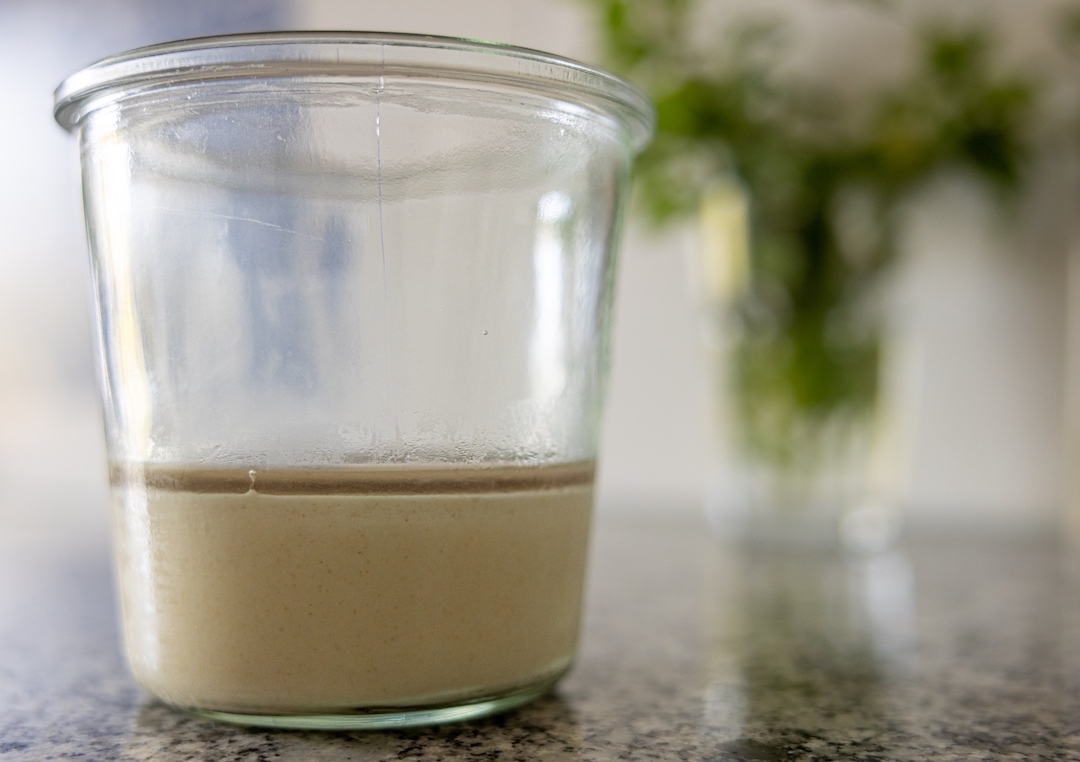
Simply stir your sourdough starter to homogenize the hooch back into your starter. The hooch will disappear. Then use a little bit of your sourdough starter to set up the starter for your next bread. Once hooch appears, your starter has likely fermented for a long period of time. It might be very sour. This state of starter is excellent to make discard crackers or a discard bread. Don’t throw anything away. Your hooch is a sign that you have a long fermented dough in front of you. Compare it to a two year ripened Parmigiano cheese. The dough in front of you is full of delicious flavor.
12.1.8 Fixing a moldy sourdough starter🔗
First of all, making a moldy sourdough starter is very difficult. It’s an indicator that something might be completely off in your starter. Normally the symbiosis of yeast and bacteria does not allow external pathogens such as mold to enter your sourdough starter. The low pH created by the bacteria is a very hostile environment that no other pathogens like. Generally everything below a pH of 4.2 can be considered food safe [17]. This is the concept of pickled foods. And your sourdough bread is essentially pickled bread.
I have seen this happening especially when the sourdough starter is relatively young. Each flour naturally contains mold spores. When beginning a sourdough starter, all the microorganisms start to compete by metabolizing the flour. Mold can sometimes win the race and outcompete the natural wild yeast and bacteria. In that case simply try cultivating your sourdough starter again. If mold reappears again, it might be a very moldy batch of flour. Try a different flour to begin your sourdough starter with.
Mature sourdough starters should not go moldy unless the conditions of the starter change. I have seen mold appearing when the starter is stored in the fridge and the surface dried out. It also sometimes forms on the edges of your starter’s container, typically in areas where no active starter microorganisms can reach. Simply try to extract an area of your starter that has no mold. Feed it again with flour and water. After a few feedings, your starter should be back to normal. Take only a tiny bit of starter: 1 g to 2 g are enough. They already contain millions of microorganisms.
Mold favors aerobic conditions. This means that air is required in order for the mold fungus to grow. Another technique that has worked for me was to convert my sourdough starter into a liquid starter. This successfully shifted my starter from acetic acid production to lactic acid production. Acetic acid, similarly to mold, requires oxygen to be produced. After submerging the flour with water, over time the lactic acid bacteria outcompeted the acetic acid bacteria. This is a similar concept to pickled foods. By doing this you are essentially killing all live mold fungi. You might only have some spores left. With each feeding the spores will become fewer and fewer. Furthermore, it seems that lactic acid bacteria produce metabolites that inhibit mold growth [27].
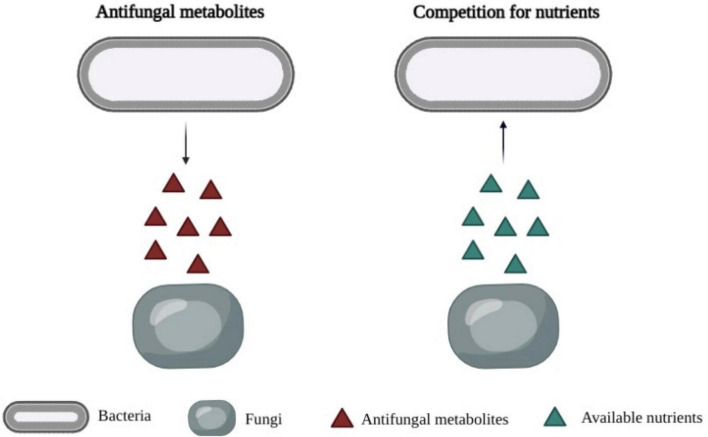
To pickle your starter, simply take a bit of your existing starter (5 g for instance). Then feed the mixture with 20 g of flour and 100 g of water. You have created a starter with a hydration of around 500 %. Shake the mixture vigorously. After a few hours you should start seeing most of the flour near the bottom of your container. After a while most of the oxygen from the bottom mixture is depleted and anaerobic lactic acid bacteria will start to thrive. Take a note of the smell your sourdough starter. If it was previously acetic it will now change to be a lot more dairy. Extract a bit of your mixture the next day by shaking everything first. Take 5 g of the previous mixture, feed again with another 20 g of flour and another 100 g of water. After 2–3 additional feedings your starter should have adapted. When switching back to a hydration of 100 % the mold should have been eliminated. Please note that more tests should be conducted on this topic. It would be nice to really carefully analyze the microorganisms before the pickling and after.
12.1.9 My sourdough starter is too sour🔗
If your sourdough starter is too sour it will cause problems during the fermentation. Your fermentation will have more bacterial activity than yeast activity. This means you will likely create a more tangy loaf which isn’t as fluffy as it could be. The goal is to reach the right balance: Fluffy consistency from the yeast and a great, not-too-strong tang from the bacteria. This depends of course on what you are looking for in terms of taste in your bread. When making rye bread, I prefer to be more on the tangy side for instance. When the described balance is off, the first thing to check is your sourdough starter.
Note the smell of your starter. Does it smell very sour? Taste a bit of your starter too. How sour does it taste? Over time, every starter becomes more and more sour the longer you wait. But sometimes your starter becomes sour too fast. In this case apply daily feedings to your starter. Reduce the amount of old starter that you use to feed. A ratio of 1:5:5 or 1:10:10 can do wonders. In this case you would take 1 part of starter (10 g) and feed it with 50 g of flour and 50 g of water. This way the microorganisms start the fermentation in a greenfield environment. This is similar to the 10 % starter or 20 % starter ratio that you use to make a dough. These days I almost never use a 1:1:1 ratio. This only makes sense when you are initially creating your starter. You want a sour environment so that your microorganisms outcompete potential pathogens. The acidic environment is toxic to most pathogens that you do not want in your starter.
Another approach that can help is to convert your sourdough starter into a stiff starter as described in Section 4.4.
12.1.10 Why does my starter smell like vinegar or acetone?🔗
Your sourdough starter has likely produced a lot of acetic acid. Acetic acid is essential when creating vinegar. Once no additional food is left some of your starter’s bacteria will consume ethanol and convert it into acetic acid. Acetic acid has a very pungent smell. When tasting acetic acid, the flavor of your bread is often perceived as quite strong.
This is nothing bad. But if you would like to change the flavor of your final bread, consider converting your sourdough starter into a liquid starter. This will help to prioritize lactic acid-producing bacteria. Your flavor will change to dairy compared to vinegary. You can’t go back though. After the conversion your starter will never go back to acetic acid production because you have changed the tides towards primarily lactic acid fermentation. I like to have a separate rye starter. In my experiments rye starters tend to feature many acetic acid bacteria. This starter is excellent when you want to make a very hearty, strong-tasting bread. A pure rye bread tastes excellent when made with such a starter. The flavor when taking a bite is incredible. It nicely plays with soups as well. Just take a bit of this bread and dip it in your soup.
12.1.11 Why does my starter not float after using the float test?🔗
The float test may not reliably determine your starter’s readiness for dough inoculation. While it’s effective for wheat-based doughs, where ample gas gets trapped in the gluten matrix, it’s less reliable for non-wheat doughs. In non- wheat doughs, the gas generated during fermentation tends to escape, causing the starter to likely sink.
For more accurate assessments of your starter’s readiness, watch for bubbles at the container’s edge and consider its aroma. A mature starter should emit a mildly sour scent without being overly pungent.
12.2 Dough🔗
12.2.1 Should I autolyse my dough?🔗
In 95 % of all cases, an autolysis makes no sense. Instead I recommend that you conduct a fermentolysis. You can read more about the autolysis process in Section 7.6 and more about the topic of fermentolysis in Section 7.7.
The fermentolysis combines all the benefits of the autolysis while eliminating disadvantages such as having to knead the dough multiple times.
The autolysis only makes sense when you might bake a fast-fermenting yeast-based dough with a high yeast inoculation rate. But even in that case you could just lower the amount of yeast to fermentolyse rather than autolyse.
12.2.2 My dough sample (aliquot) doesn’t rise. What’s wrong?🔗
If you see that your dough rises in size but your aliquot doesn’t, chances are that both are fermenting at different speeds. This can often happen when the temperature in your kitchen changes. The aliquot is more susceptible to temperature changes than the main dough. Because the sample is smaller in size, it will heat up or cool down faster.
For this reason, you must use room-temperature water when making your dough. By having the same temperature in both the sample and your dough, you make sure that both ferment at the same rate.
If the temperature in your room changes significantly during the day, your best option is to use a see-through container. Mark the container to properly measure your dough’s size increase.
Another option could be to use a more expensive pH meter to measure your dough’s acidity buildup. You can read more about different ways of managing bulk fermentation in Section 7.9.
12.2.3 What’s a good level of water (hydration) to make a dough?🔗
Especially when starting to make bread, use lower amounts of water. This will greatly simplify the whole process. I recommend using a level of around 60 % hydration. So for every 100 g of flour use around 60 g of water. This ballpark figure will work for most flours. With this hydration, you can make bread, buns, pizzas, and even baguettes out of the same dough.
With the lower hydration, dough handling becomes easier and you have more yeast fermentation, resulting in lower over-fermentation risk.
12.2.4 My dough completely tears after a long fermentation🔗
Sometimes when touching your dough after a long fermentation it completely tears apart. This could be for two reasons. It might be that the bacteria completely consumed the gluten of your flour. On the other hand, over time your gluten network automatically degrades. This is the protease enzyme converting the gluten network into smaller amino acids the seedling can use as building blocks for its growth. This process starts to happen the moment you mix flour and water. The longer your dough sits, the more gluten is broken down. As the gluten holds the wheat dough together, your dough will ultimately tear.
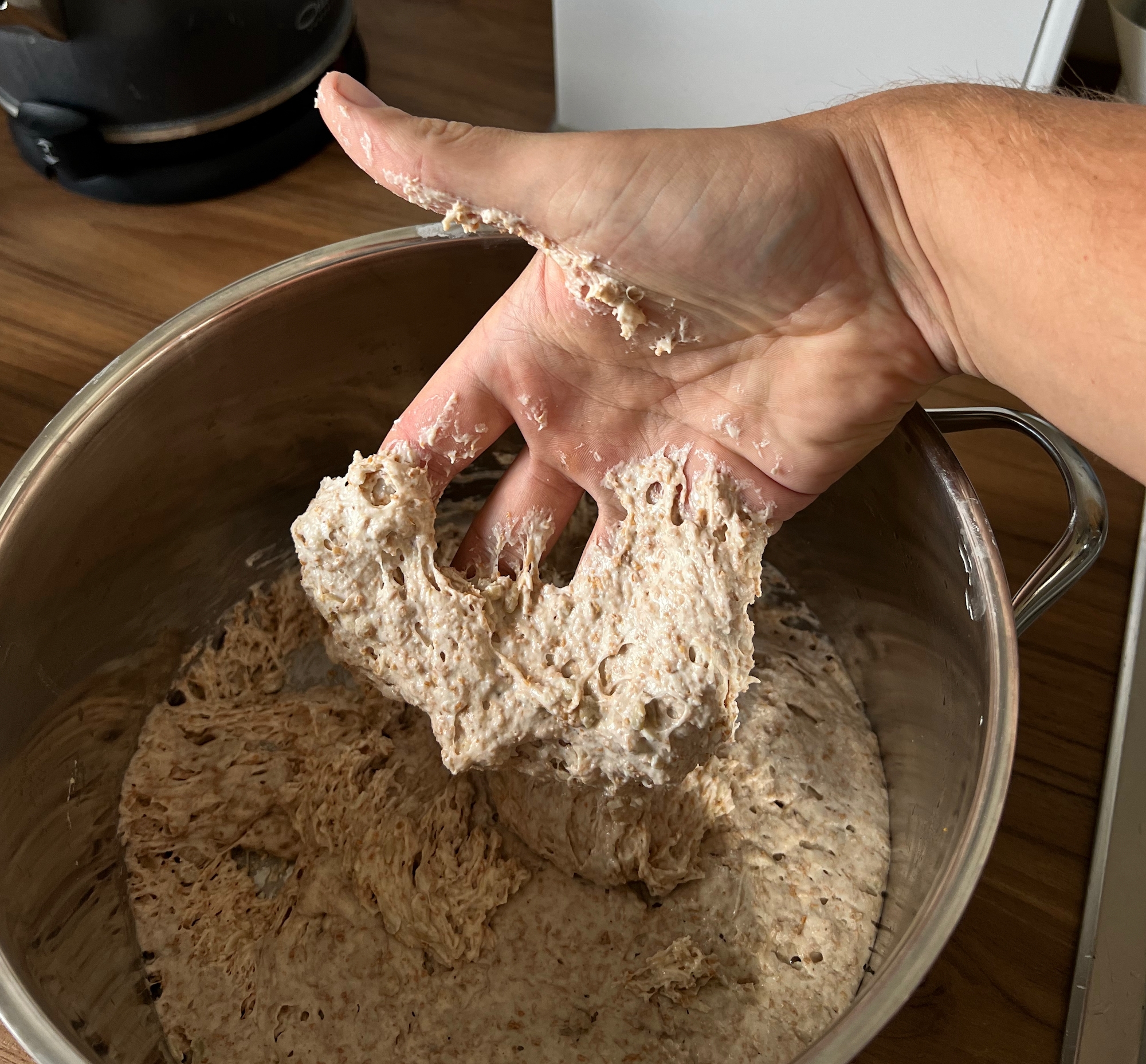
In the picture 12.4 I experimented with using a starter that has not been fed for 30 days at room temperature. I tried to make a dough directly out of the unfed starter. Typically after a long period without feedings your microbes start to sporulate and go into hibernation mode. This way they can survive for a long period of time without extra feedings. Adding additional food will activate them again. In this case the dough did not ferment fast enough before the protease broke down the gluten. By activating your microbes they will start to reproduce and increase in quantity for as long as there is food available. But this process in my case was not fast enough. After around 24 hours, the whole dough just started to completely tear apart. The whole process was further accelerated by my using whole-wheat flour. Whole-wheat contains more enzymes than white flour.
To fix this, try to make sure that your sourdough starter is lively and active. Simply apply a couple more feedings before making your dough. This way your dough becomes ready to shape before it has completely broken down.
12.3 Bread🔗
12.3.1 My bread stays flat🔗
A flat bread is in most cases related to your gluten network breaking down fully. This is not bad; this means you are eating a fully fermented food. However, from a taste and consistency perspective, it might be that your bread tastes too sour, or is not fluffy anymore. Please also note that you can only make bread with great oven spring when making wheat based doughs. When starting with this hobby I always wondered why my rye breads would turn out so flat. Yes, rye has gluten, but small particles called pentosans (arabinoxylan and beta-glucan) [10]. They prevent the dough from developing a gluten network it can with wheat. Your efforts will be in vain, and your dough will stay flat. Only spelt- and wheat-based doughs have the capability of retaining the CO created by the fermentation.
In most cases something is probably off with your sourdough starter. This very often happens when the starter is still relatively young and isn’t as capable of fermenting flour. Over time your sourdough starter is going to become better and better. Keep your sourdough starter at room temperature and then apply daily feedings with a 1:5:5 ratio. This would be 1 part old starter, 5 parts flour, 5 parts water. This allows you to achieve a better balance of yeast and bacteria in your sourdough. Even better could be the use of a stiff sourdough starter. The stiff sourdough starter boosts the yeast part of your starter. This allows you to have less bacterial fermentation, resulting in a stronger gluten network toward the end of the fermentation [37]. Please also refer to the Subsection 12.4.2 where I explained more about overfermented doughs. You can also refer to Section 4.4 with more details on making a stiff sourdough starter.
Furthermore, a stronger flour containing more gluten will help you to push the fermentation further. This is because your flour contains more gluten and will take longer to be broken down by your bacteria. Ultimately, if fermented for too long, your dough is also going to be broken down and will become sticky and flat.
To debug whether the excess bacterial fermentation is the issue, simply taste your dough. Does it taste very sour? If yes, that’s a good indicator. When working the dough, does it suddenly become very sticky after a few hours? That’s a another good indicator. Please also use your nose to note the smell of the dough. It shouldn’t be too pungent.
12.3.2 I want more tang in my bread🔗
To achieve more tang in your sourdough bread, you have to ferment your dough for a longer period of time. Over time the bacteria will metabolize most of the ethanol created by the yeast in your dough. The bacteria mostly produce lactic and acetic acid. Lactic acid is chemically more acidic than acetic acid but sometimes not perceived as sour. In most cases a longer fermentation is what you want. You will either need to utilize a loaf pan to make your dough or use a flour that can withstand a long fermentation period. A flour like this is typically called a strong flour. Stronger flours tend to be from wheat varieties that have be grown in more sunny conditions. Because of that, stronger flours tend to be more expensive. For freestanding loaves, I recommend using a flour that contains at least 12 % protein. Generally, the more protein, the longer you can ferment your dough.
Another option to achieve a more sour flavor could be to use a starter that produces more acetic acid. Based on my own experience, most of my pure rye starters produced stronger acetic notes. Chemically, the acetic acid isn’t as sour, but when tasting it will seem more sour. Make sure to use a starter that is at a hydration of around 100 %. Acetic acid production requires oxygen. A starter that is too liquid tends to favor lactic acid production because the flour is submerged in water. By submerging the dough very little oxygen can pass through the water to the fermenting flour. Because of this, only very little acetic acid can be produced. Over time the acetic acid-producing bacteria will perish from your starter.
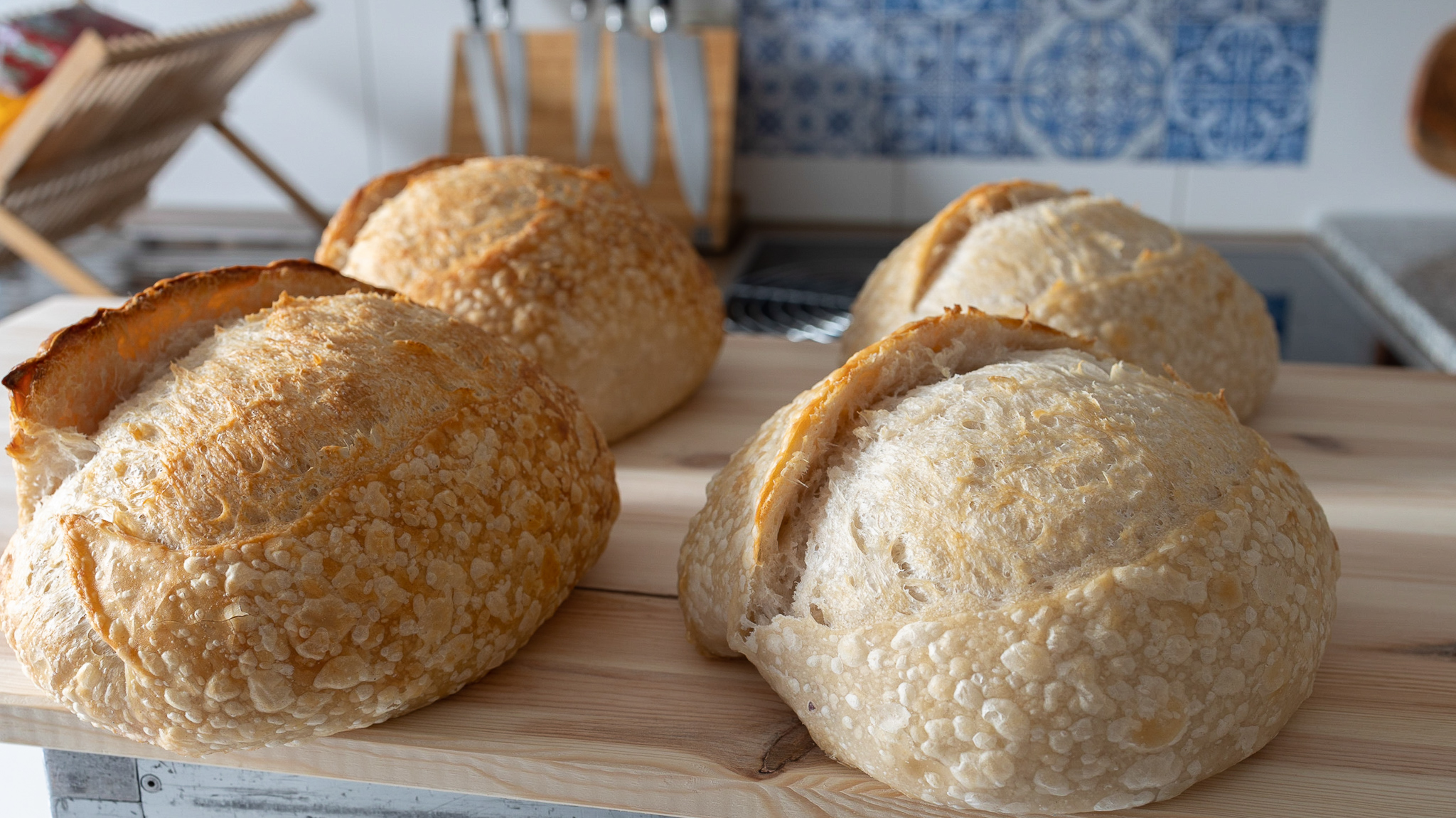
Another easier option could be to bake your sourdough twice. I have observed this when shipping bread for my micro bakery. The idea was to bake my bread for around 30 minutes until it’s sterilized, let it cool down and then ship it to customers. Once you receive it, you just bake it again for another 20–30 minutes to achieve the desired crust and then you can eat it. Some of the customers reported a very sour tasting bread. After investigating a bit more, it became crystal clear. By baking the bread twice you don’t boil off as much acid during the baking process. Water evaporates at around 100 °C (212 °F) while acetic acid boils at 118 °C (244 °F) and lactic acid at 122 °C (252 °F). After baking for 30 minutes at around 230 °C (446 °F) some of the water has started to evaporate, but not all the acid yet. If you were to continue to bake, more and more of the acid would start to evaporate. Now if you were to stop baking after 30 minutes, you would typically have reached a core temperature of around 95 °C (203 °F). Your dough would need to be cooled down again to room temperature. The crust would still be quite pale. Then a couple of hours later, you start to bake your dough again. Your crust would become nice and dark featuring delicious aroma. The aroma is coming from the Maillard reaction. However, the core of your dough still won’t exceed the 118 °C required to boil the acid. Overall, your bread will be more sour. The enhanced acidity also helps to prevent pathogens from entering your bread. The bread will be good for a longer period of time. That’s why the concept of a delivery bakery works well with tangy sourdough bread. In my own experiments, the bread stayed good for up to a week in a plastic bag. This is much longer than a yeast-based dough that might mold after just a few days.1
12.3.3 My bread is too sour🔗
Some people like the bread less sour as well. This is personal preference. To achieve a less sour bread you need to ferment for a shorter period of time. The yeast produces CO and ethanol. Both yeast and bacteria consume the sugars released by the amylase enzyme in your dough. When the sugar is depleted, bacteria starts to consume the leftover ethanol by the yeast. Over time more and more acidity is created, making a more sour loaf.
Another angle at this would be to change the yeast/bacteria ratio of your sourdough. You can start the fermentation with more yeast and less bacteria. This way, for the same given volume increase of your dough, you will have less acidity. A really good trick is to make sure that you feed your starter once per day at room temperature. This way you shift the tides of your starter towards a better yeast fermentation [34].
To shift the tides even further, a real game changer for me has been to create a stiff sourdough starter. The stiff sourdough starter is at a hydration of around 50 %. By doing so your sourdough starter will favor yeast activity a lot more. Your doughs will be more fluffy and less sour for a given volume increase. I tested this by putting balloons over different glass jars. I used the same amount of flour for each of the samples. I tested a regular starter, a liquid starter and a stiff starter. The stiff starter by far created the most CO compared to the other starters. As a consequence, the stiff starter balloon was inflated the most [37]. You can read more about the topic of stiff starters in Section 4.4.
Another unconventional approach could be to add baking powder to your dough. The baking powder neutralizes the lactic acid and will make a much milder dough [38].
12.3.4 My bread flattens out when removing it from the banneton🔗
After removing your dough from the banneton, your dough will always flatten out a bit. That’s because over time your gluten network relaxes and can no longer hold the shape. However, during the course of baking, your dough is going to increase in size and inflate again.
If your dough however flattens out completely, it’s a sign that you have fermented your dough for too long. Please refer to Subsection 12.4.2 where I explain about overfermented doughs. Your bacteria has consumed most of your gluten network. That’s why your dough fully collapses and stays flat during the bake. The CO and evaporating water will diffuse out of the dough. A related symptom is that your dough sticks to the banneton. When I starting baking I combated this with rice flour. It worked for me but it might be a false find. Please refer to Subsection 12.4.2 for more details on why rice flour is not a good idea to manage sticky doughs.
These days I gently rub my dough with a bit of non-rice flour before placing it in the banneton. Now if the dough starts to stick to the banneton while I remove it I resort to a drastic measure. I immediately grease a loaf pan and directly place the dough inside. The loaf pan provides a barrier and the dough can’t flatten out as much. The dough won’t be as fluffy but it will be super delicious if you love tangy bread.
If you own a pH meter, take a note of your dough’s pH before baking. This will allow you to better judge your dough throughout the fermentation process.
12.3.5 My bread flattens out during shaping🔗
Similarly to a dough flattening out after removing it from the banneton, a flattened dough after shaping is also a possible sign of over-fermentation.
When you try to shape the dough, can you easily tear pieces from the dough? If yes, you have definitely overfermented your dough. If not, it might just be a sign that you have not created enough dough strength for your dough. A ciabatta, for instance, is a dough that tends to flatten out a bit after shaping.
If your dough is not able to be shaped at all, use a greased loaf pan to rescue your dough. You can also cut a piece of the dough and use it as the starter for your next dough. Your sourdough dough is essentially just a gigantic starter.
12.3.6 My crust becomes chewy🔗
Depending on which style of bread you are making a thick crackly crust is sometimes desired. The crust of your bread is created during the 2nd stage of the baking process once the steaming source of your oven has been removed. The dark colors are created by the process known as Maillard reaction and then followed by another process known as caramelization. Each color of crust offers the taster a different aroma.
What happens quite often is that the crust becomes chewy after a day. Sometimes when baking in the tropics with high humidity, the crust only stays in this stage for a few hours. Afterwards the crust becomes chewy. It’s no longer as crisp compared to the moment after baking. Your dough still contains moisture. This moisture will start to homogenize in the final bread and partially evaporate. The result is that your crust becomes chewy.
Similarly when storing your bread in a container or in a plastic bag, your crust is going to become chewy. I have no fix for this yet. I typically tend to store my breads in a plastic bag inside of my fridge. This allows the moisture to stay inside of bread. When taking a slice I always toast each slice. This way some of the crispness returns. If you know of a great way, please reach out and I will update this book with your findings.
12.4 Debugging your crumb structure🔗
The crumb structure of your bread provides insights into how well your fermentation process has gone. You can also spot common flaws arising from improper technique. This chapter will provide you with information that you can use to debug your baking process.
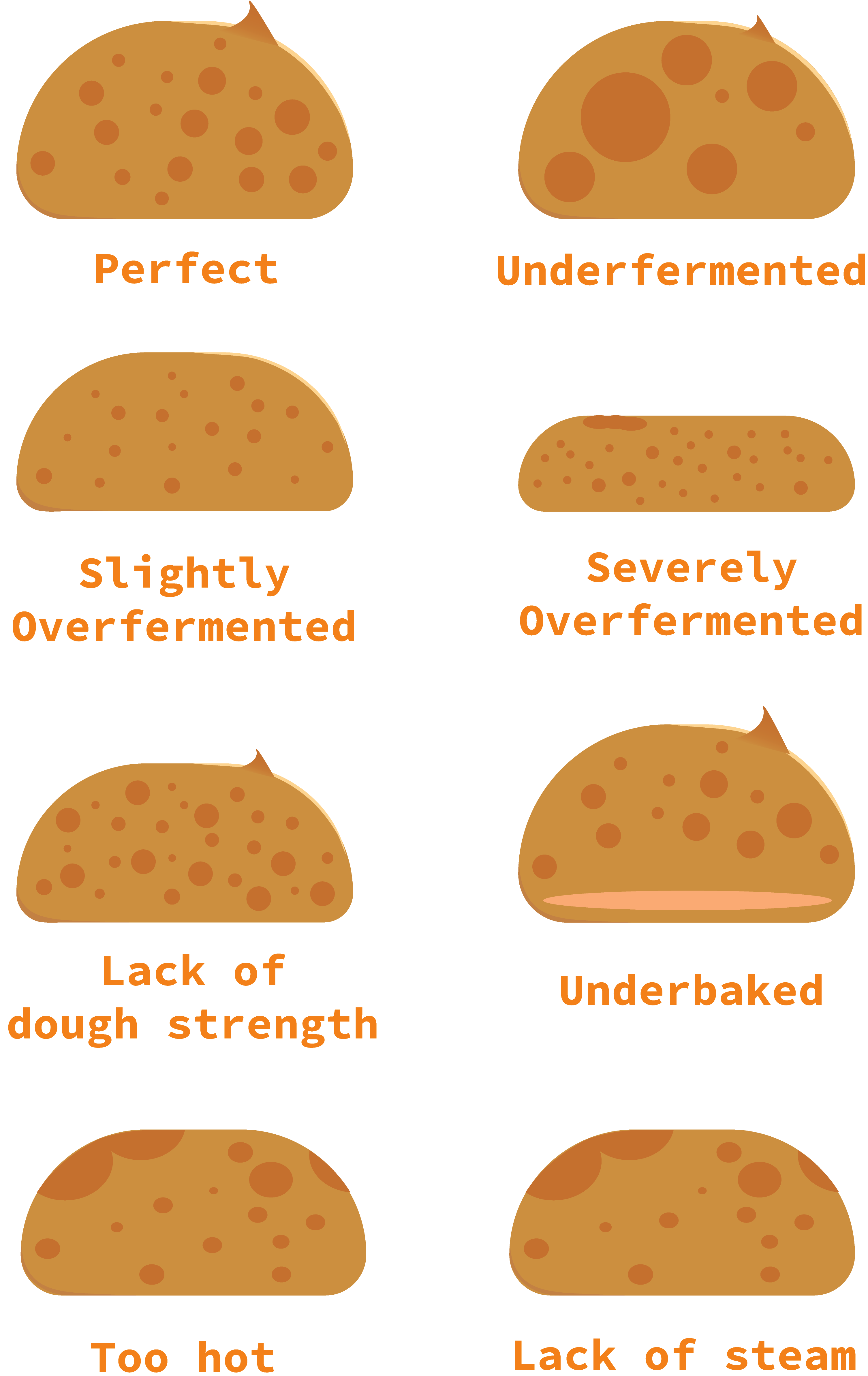
12.4.1 Perfect fermentation🔗
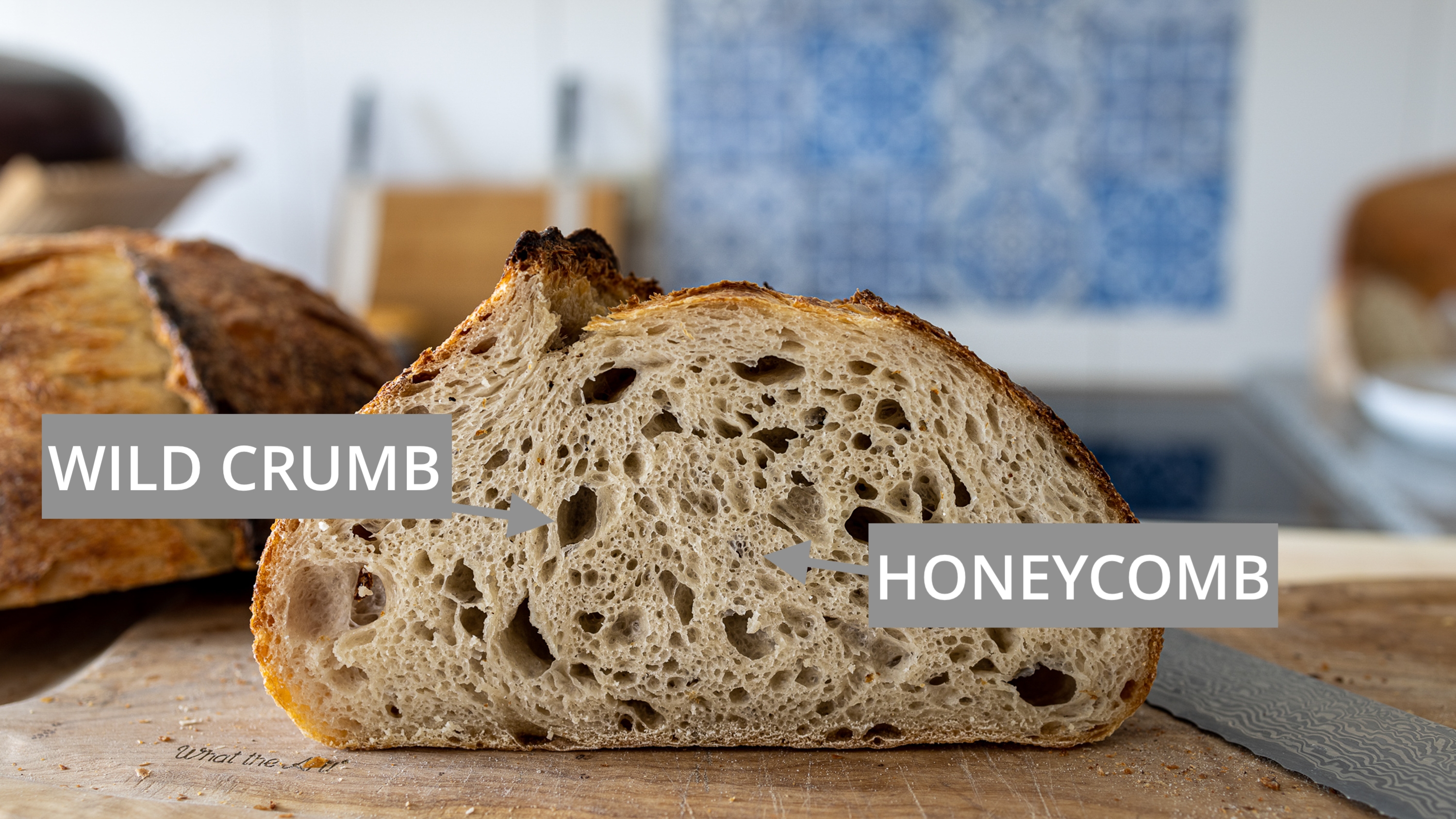
Of course the perfect fermentation is debatable and highly subjective. To me the perfect sourdough bread features a crisp crust paired with a fluffy, somewhat open crumb. This is the perfect balance of different consistencies when you take a bite.
Some people are chasers of a very open crumb, meaning you have large pockets of air (alveoli). It’s subjective whether that’s the style of bread that you like; however, to achieve it you need to ferment your bread dough perfectly. It takes a lot of skill both in terms of mastering fermentation and technique to achieve a crumb structure like that.
Personally, I like a bread like that, just with a slightly less wild crumb. The style of crumb I like is called the honeycomb crumb. It’s not too open, but just enough open to make the bread very fluffy. To achieve the previously mentioned open crumb, you have to touch your dough as little as possible. The more you interact with your dough, the more you are degassing your dough. Excess touching of the dough results in the dough’s alveoli merging together. The crumb will not be as open. That’s why achieving such a crumb works best if you only ferment one loaf at a time. Normally, if you have to pre-shape your dough, you will automatically degas your dough a little bit during the rounding process. If you skip this step and directly shape your dough, you will achieve a more open crumb. A good rule of thumb is to not touch your dough for at least 1–2 hours before shaping, to achieve as open a crumb as possible.

Now this is problematic when you want to make multiple loaves at the same time. Pre-shaping is essential as you are required to divide your large bulk dough into smaller chunks. Without the pre-shaping process, you would end up with many non-uniform bread doughs. This technique is also used when making ciabattas. They are typically not shaped. You only cut the bulk dough into smaller pieces, trying to work the dough as little as possible. With pre-shaping you will converge your dough’s alveoli into more of a honeycomb structure, as large pockets of air will slightly merge. Similarly to the open crumb structure, you also have to nail the fermentation process perfectly to achieve this crumb. Too long a fermentation will result in gas leaking out of your dough while baking. The honeycombs won’t be able to retain the gas. If you ferment for too short a time, there is not enough gas to inflate the structures. To me this is the perfect style of crumb. As someone who appreciates jam, no jam will fall through a slice of this bread compared to an open crumb.
12.4.2 Overfermented🔗

When fermenting your dough for too long, the protease enzyme starts to break down the gluten of your flour. Furthermore, the bacteria consume the gluten in a process called proteolysis [30]. Bakers also refer to this process as gluten rot. The gluten that normally traps the CO created by the fermentation process of your microorganisms can no longer keep the gas inside of the dough. The gas disperses outward resulting in smaller alveoli in your crumb. The bread itself tends to be very flat in the oven. Bakers often refer to this style of bread as a pancake. The oven spring can be compared to bread doughs made out of low-gluten flour like einkorn.
Your bread will feature a lot of acidity, a really strong distinctive tang. From a taste perspective, it might be a little bit too sour. From my own tests with family and friends (n=15–20), I can say that this style of bread is typically appreciated less. However, I personally really like the hearty strong taste. It is excellent in combination with something sweet or a soup. From a consistency perspective, it is no longer as fluffy as it could be. The crumb might also taste a little bit gummy. That’s because it has been broken down a lot by the bacteria. Furthermore, this style of bread has a significantly lower amount of gluten [30] and is no longer comparable to raw flour, it’s a fully fermented product. You can compare it with a blue cheese that is almost lactose free.
When trying to work with the dough, you will notice that suddenly the dough feels very sticky. You can no longer properly shape and work the dough. When trying to remove the dough from a banneton, the dough flattens out a lot. Furthermore, in many cases your dough might stick to the banneton. When beginning with baking I would use a lot of rice flour in my banneton to dry out the surface of the dough a lot. This way the dough wouldn’t stick, despite being overfermented. However as it turns out the stickiness issue has been my lack of understanding the fermentation process. Now I never use rice flour, except when trying to apply decorative scorings. Managing properly fermentation results in a dough that is not sticky.
If you are noticing, during a stretch and fold or during shaping, that your dough is suddenly overly sticky, then the best option is to use a loaf pan. Simply take your dough and toss it into a loaf pan. Wait until the dough mixture has increased in size a bit again and then bake it. You will have a very good-tasting sourdough bread. If it’s a bit too sour, you can just bake your dough for a longer period of time to boil away some of the acidity during the baking process. You can also use your dough to set up a new starter and try again tomorrow. Lastly, if you are hungry, you can simply pour some of your dough directly into a heated pan with a bit of oil. It will make delicious sourdough flatbreads.
To fix issues related to over-fermentation, you need to stop the fermentation process earlier. What I like to do is to extract a small fermentation sample from my dough. Depending on the volume increase of this sample, I can mostly judge when my fermentation is finished. Try to start with a 25 % volume increase of your main dough or sample. Depending on how much gluten your flour has, you can ferment for a longer period of time. With a strong flour featuring a 14 % to 15 % protein, you should be able to safely ferment until a 100 % size increase. This however also depends on your sourdough starter’s composition of yeast and bacteria. The more bacterial fermentation, the faster your dough structure breaks down. Frequent feedings of your sourdough starter will improve the yeast activity. Furthermore, a stiff sourdough starter might be a good solution too. The enhanced yeast activity will result in a more fluffy dough with less bacterial activity. A better yeast activity also will result in less acidity in your final bread. If you are a chaser of a very strong tangy flavor profile, then a stronger flour with more gluten will help.
When retarding sourdough (cold-proofing in the refrigerator), temperature plays a pivotal role in fermentation rates. As the dough chills in the refrigerator, fermentation decelerates. Starting the retarding process at a warmer temperature means this deceleration takes longer.
For instance, a dough that’s ideal after 8 hours of retarding might be ready in merely 4 hours if it began at a higher temperature. Thus, it’s crucial to experiment and determine the optimal retarding duration for your specific conditions. Conversely, if the dough starts colder, fermentation halts more rapidly in the refrigerator. In such scenarios, allowing the dough to proof at room temperature briefly before refrigerating can be beneficial.
12.4.3 Underfermented🔗
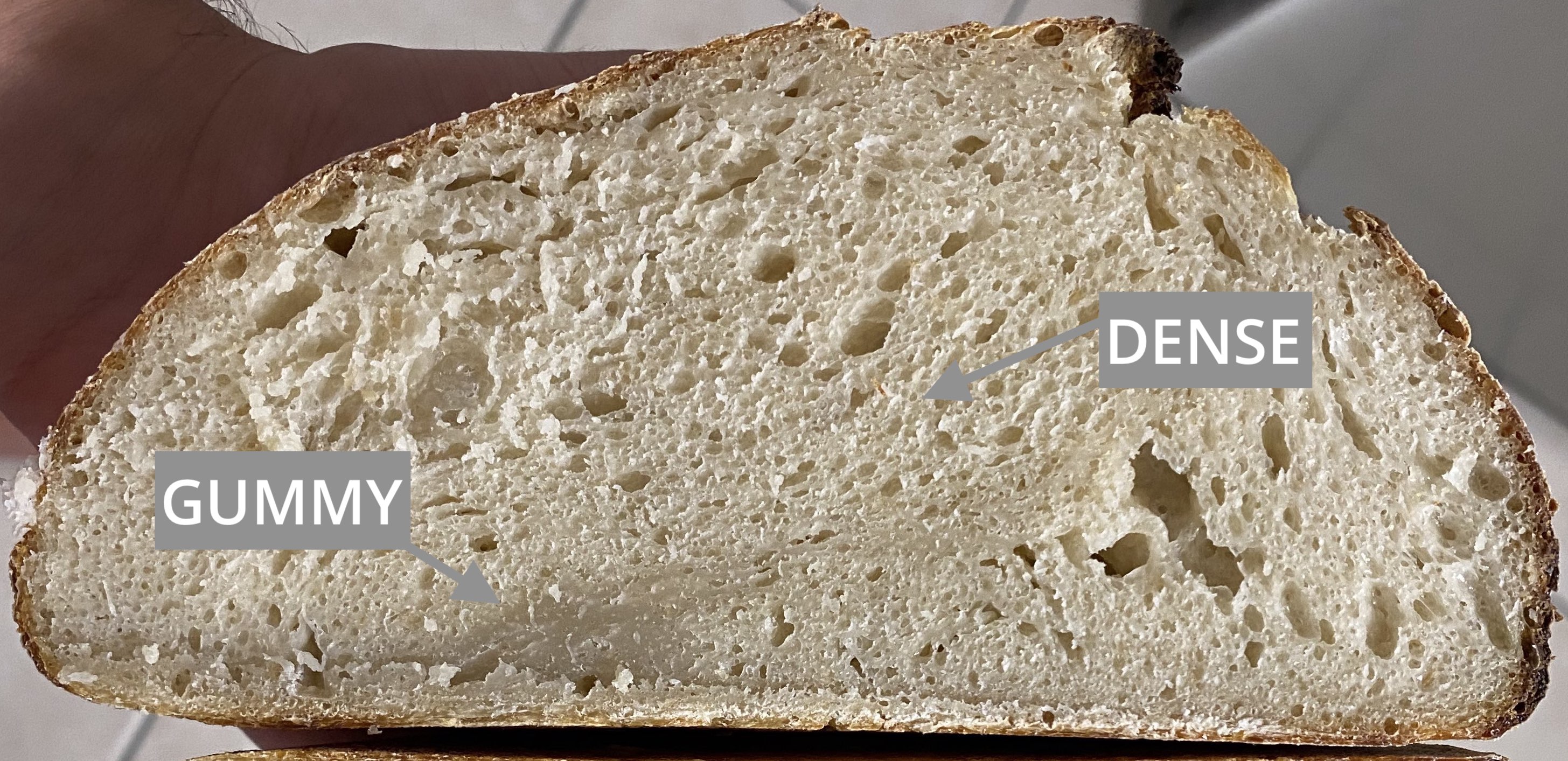
This defect is also commonly referred to as underproofed. However underproofed is not a good term as it only refers to having a short final proofing stage of the bread-making process. If you were to bake your bread after a perfectly-timed bulk fermentation stage, the result will not be underproofed even if you skipped the proofing stage entirely. Proofing will make your dough a bit more extensible and allows your sourdough to inflate the dough a bit more. When faced with an underfermented bread, something went wrong earlier during the bulk fermentation stage, or maybe even before with your sourdough starter.
A typical underfermented dough has very large pockets of air and is partially wet and gummy in some areas of the dough. The large pockets can be compared to making a non-leavened wheat or corn tortilla. As you bake the dough in your pan, the water slowly starts to evaporate. The gas is trapped in the structure of the dough and will create pockets. In case of a tortilla, this is the desired behavior. But when you observe this process in a larger dough, you will create several super alveoli. The water evaporates, and the first alveoli form. Then at some point, the starch starts to gelatinize and becomes solid. This happens first inside of the pockets as the interior heats up faster compared to the rest of the dough. Once all the starch has gelatinized, the alveoli holds their shape and no longer expand. During this process other parts of the bread dough are pushed outwards. That’s why an underfermented dough sometimes even features an ear during the baking process. This is also commonly referred to as a fool’s crumb. You are excited about an ear which can be quite hard to achieve. Plus you might think you finally created some big pockets of air in your crumb. But in reality you fermented for too short a period of time.
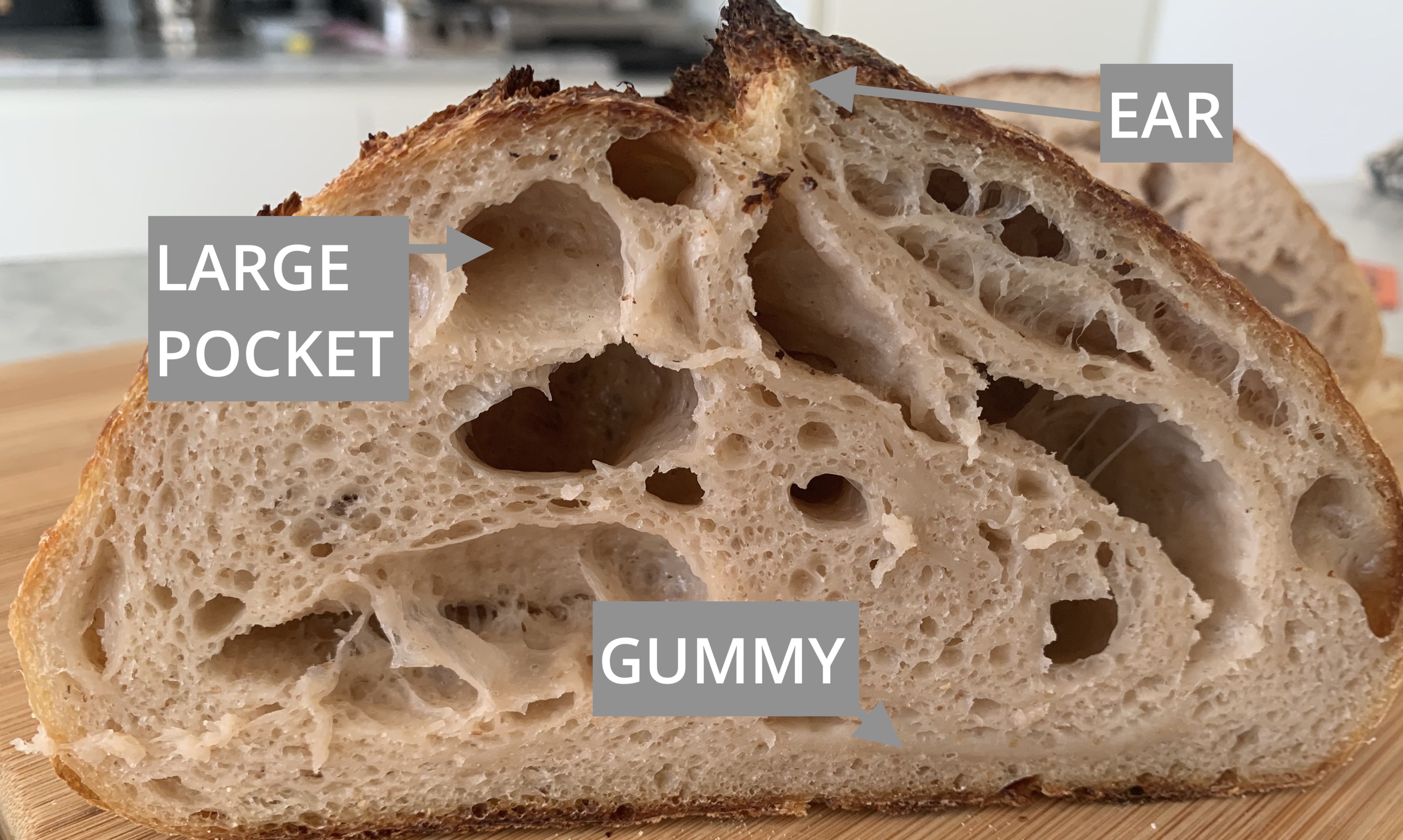
In a properly fermented dough, the alveoli help with the heat transfer throughout the dough. From within the many tiny fermentation-induced pockets, the starch gelatinizes. With an underfermented dough, this heat transfer does not properly work. Because of that you sometimes have areas which look like raw dough. Bakers refer to this as a very gummy structure sometimes. Baking your dough for a longer period of time would also properly gelatinize the starch in these areas. However, then other parts of your bread might be baked too long.
To fix issues related to under-fermentation, you simply have to ferment your dough for a longer period of time. Now, there is an upper limit to fermentation time as your flour starts to break down the moment it is in contact with water. That’s why it might be a good idea to simply speed up your fermentation process. As a rough figure, I try to aim for a bulk fermentation time of around 8–12 hours typically. To achieve that you can try to make your sourdough starter more active. This can be done by feeding your starter daily over several days. Use the same ratio as you would do for your main bread dough. Assuming you use 20 % starter calculated on the flour, use a 1:5:5 ratio to feed your starter. That would be 10 g of existing starter, 50 g of flour, 50 g of water for instance. To boost your yeast activity even more, you can consider making a stiff sourdough starter. The bacteria produces mostly acid. The more acidity is piled up, the less active your yeast is. The stiff sourdough starter enables you to start your dough’s fermentation with stronger yeast activity and less bacterial activity.
12.4.4 Not enough dough strength🔗
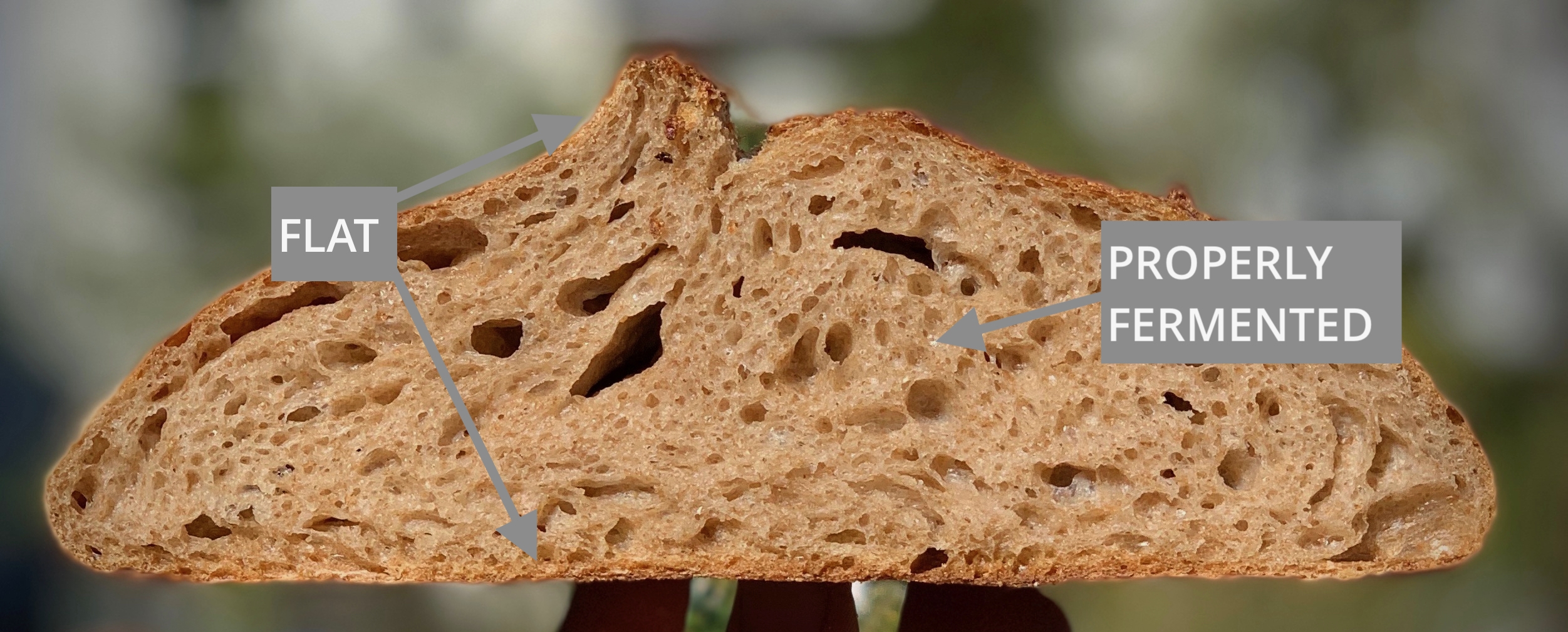
When a dough flattens out quite a lot during the baking process, the chances are that you did not create enough dough strength. This means your gluten matrix hasn’t been developed properly. Your dough is too extensible and flattens out mostly rather than springing upwards in the oven. This can also happen if you proofed your dough for too long. Over time the gluten relaxes and your dough becomes more and more extensible. You can observe the gluten relaxing behavior too when making a pizza pie. Directly after shaping your dough balls, it’s very hard to shape the pizza pie. If you wait for 30–90 minutes stretching the dough becomes a lot easier.
The easiest way to fix this is probably to knead your dough more at the start. To simplify things consider using less water for your flour too. This will result in a more elastic dough right away. This concept is commonly used for no-knead style sourdough. Alternatively, you can also perform more stretch and folds during the bulk fermentation process. Each stretch and fold will help to strengthen the gluten matrix and make a more elastic dough. The last option to fix a dough with too little dough strength is to shape your dough tighter.
12.4.5 Baked too hot🔗
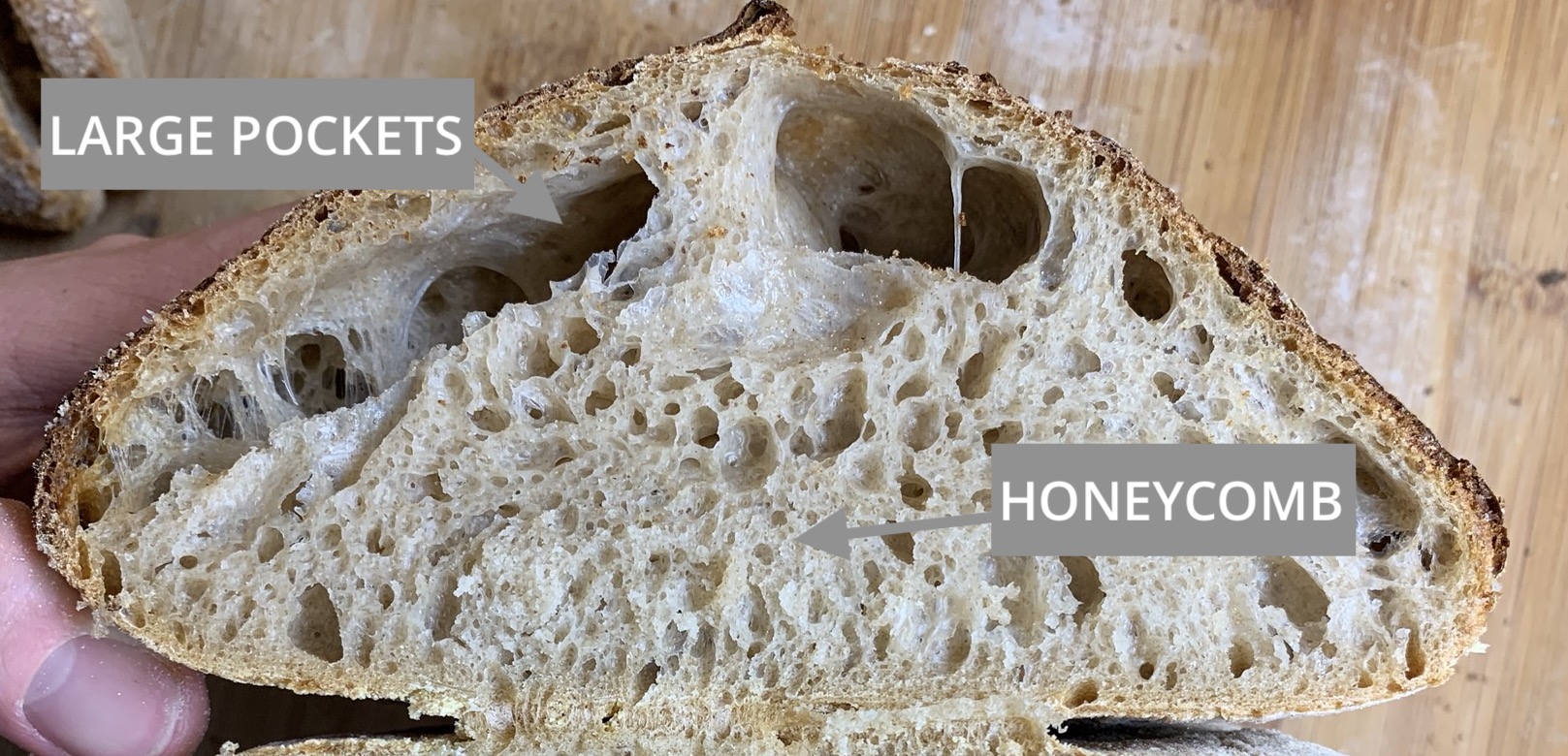
This is a common mistake that has happened to me a lot. When you bake your dough at too high a temperature, you constrain your dough’s expansion. The starch gelatinizes and becomes more and more solid. At around 140 °C (284 °F) the Maillard reaction starts to completely thicken your bread dough’s crust. This is similar to baking your bread dough without steam. As the internal dough’s temperature heats up, more and more water evaporates, gas expands and the dough is being pushed upwards. Once the dough reaches the crust, it can no longer expand. The alveoli merge into larger structures close to the surface of the dough. By baking too hot, you are not achieving the ear which adds extra flavor. Furthermore, by restricting it’s expansion, the crumb will not be as fluffy as it could be.
If you have an extensible dough with high hydration, baking too cold will result in the dough flattening out quite a lot. The gelatinization of the starch is essential for the dough to hold its structure. After conducting several experiments, it seems that my sweet spot for maximum oven spring seems to be at around 230 °C (446 °F). Test the temperature of your oven, because in several cases the displayed temperature might not match the actual temperature of your oven [35]. Make sure to turn off the fan of your oven. Most home ovens are designed to vent the steam as fast as possible. If you can not turn the fan off, consider using a Dutch oven.
12.4.6 Baked with too little steam🔗
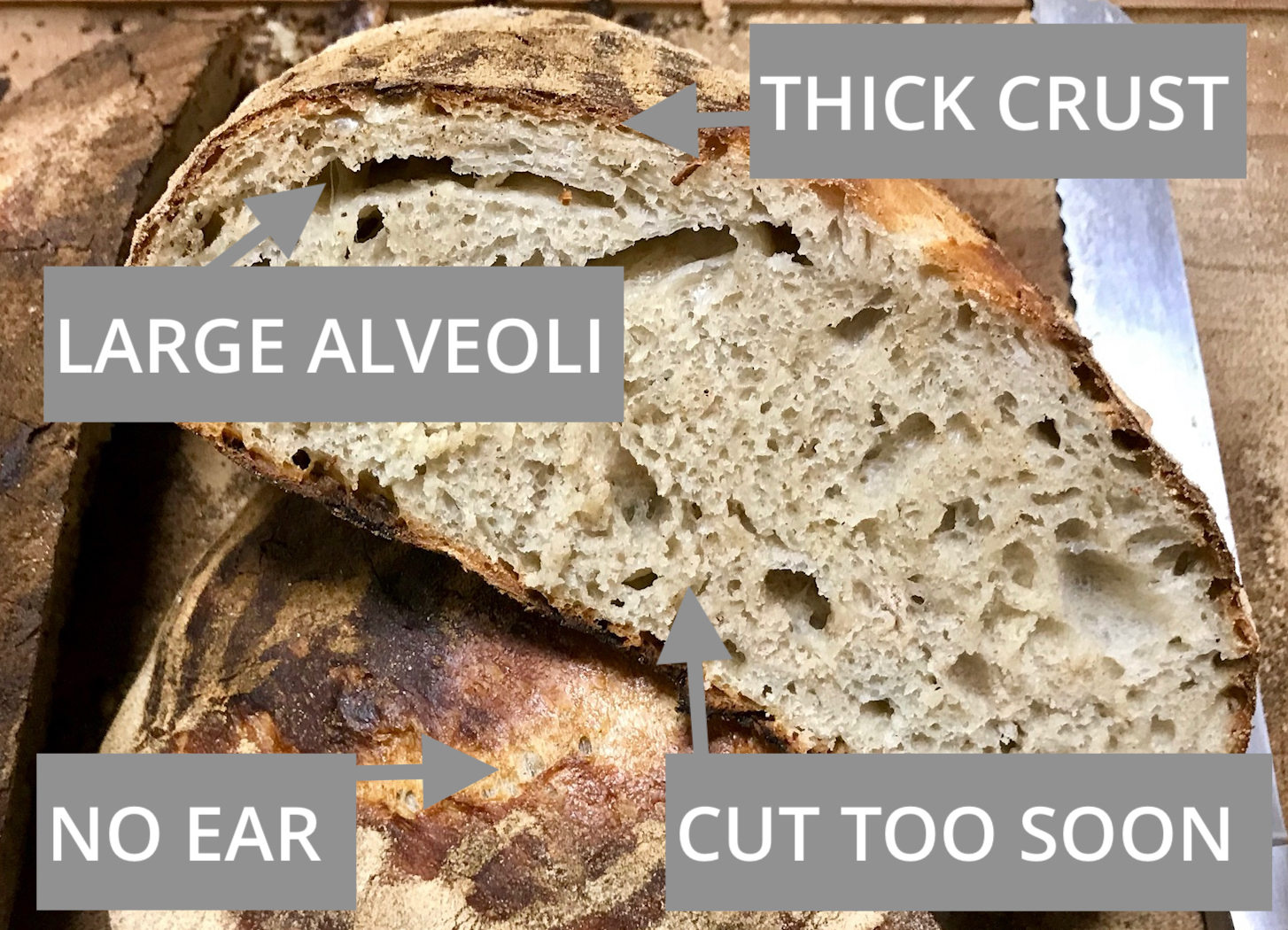
Similar to baking too hot, when baking without enough steam, your dough’s crust forms too quickly. It’s hard to spot the difference between the two mistakes. I typically first ask about the temperature and then about the steaming technique to determine what might be wrong with the baking process. Too little steam can typically be spotted by having a thick crust all around your dough paired with large alveoli towards the edges.
The steam essentially prevents the Maillard reaction from happening too quickly on your crust. That’s why steaming during the first stages of the bake is so important. The steam keeps the temperature of your crust close to around 100 °C (212 °F). Achieving steam can be done by using a Dutch oven, an inverted tray and/or a bowl of boiling water. You might also have an oven with a built-in steam functionality. All the methods work, it depends on what you have at hand. My default go-to method is an inverted tray on top of my dough, paired with a bowl full of boiling water towards the bottom of the oven.
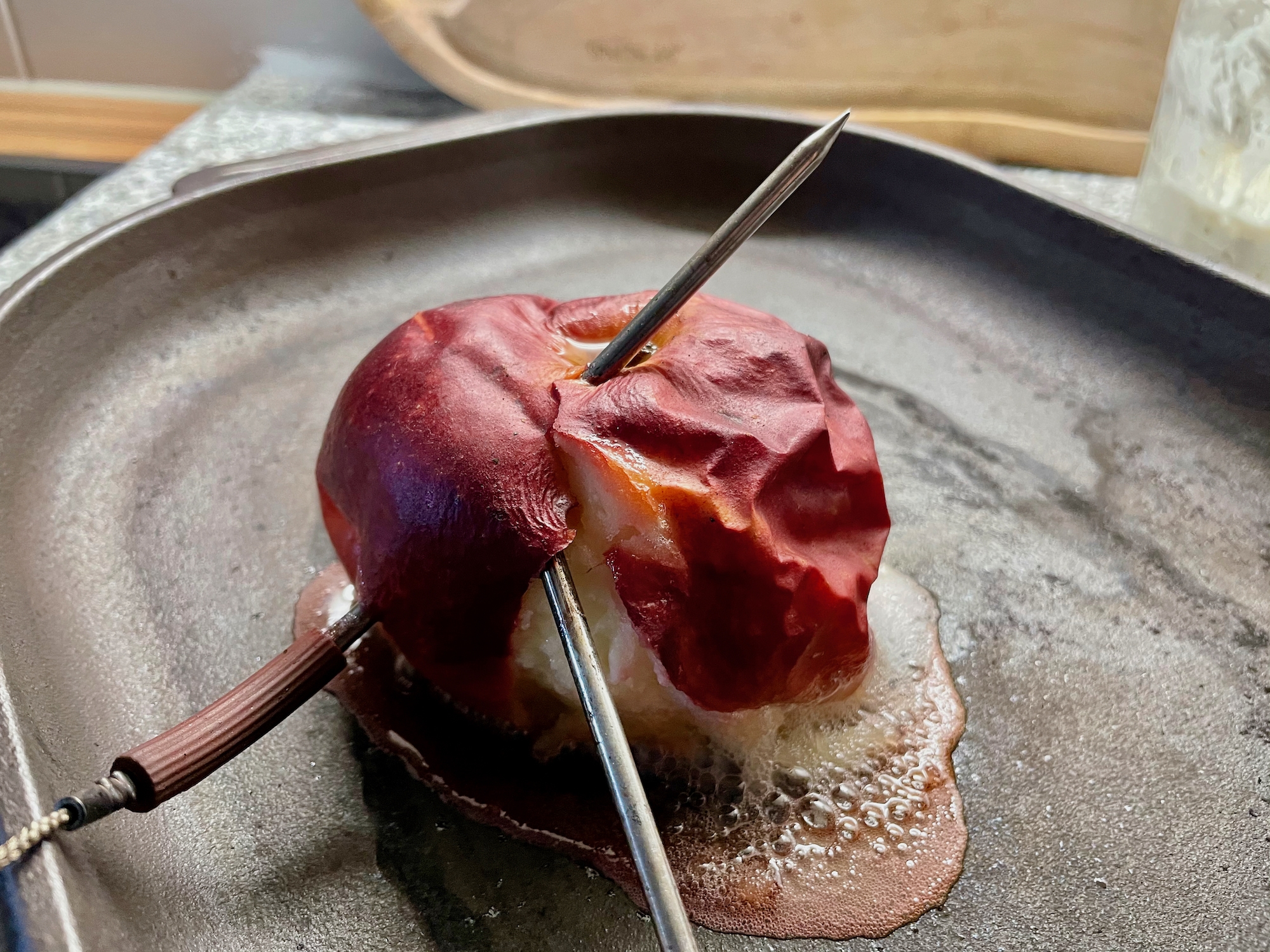
Now there can also be too much steam. For this I tested using a Dutch oven paired with large ice cubes to provide additional steam. The temperature of my dough’s surface would directly jump close to 100°C. The steam contains more energy and thus through convection can heat up the surface of your dough faster. I tested this by putting an apple inside a Dutch oven and measuring its surface temperature using a barbecue thermometer. I then changed the steaming methods to plot how quickly the temperature close to the surface changes. I tested an ice cube inside of a preheated Dutch oven, a plain preheated Dutch oven, a preheated Dutch oven with spritzes of water on the apple’s surface and a non-preheated Dutch oven where I would only preheat the bottom part. The experiment then showed that the ice-cube method would heat up the surface of the apple a lot quicker. When replicating this with a bread dough, I would achieve less oven spring.
Generally though, achieving too much steam is relatively challenging. I could only make this mistake when using a Dutch oven as the steaming method paired with relatively large ice cubes. After talking with other bakers using the same Dutch oven, it seems that my ice cubes (around 80 g) were 4 times as heavy as the ones other bakers would use (20 g).
12.5 Misc🔗
12.5.1 Baking in the tropics🔗
Depending on the temperature, your fermentation speed adapts. In a warmer environment, everything is faster. In a colder environment, everything is slower.
This includes the speed at which your sourdough ferments the dough but also the speed of enzymatic reactions. The amylase and protease enzymes work faster, making more sugars available and degrading the gluten proteins.
At around 22 °C (72 °F) in my kitchen my bulk fermentation is ready after around 10 hours. I use around 20 % of sourdough starter based on the flour. In summertime the temperatures in my kitchen sometimes increase to 25 °C (77 °F). In that case I reduce the sourdough starter to around 10 %.
If I didn’t do that, my fermentation would be done after around 4–7 hours. The problem is that the dough is quite unstable when fermenting at this high speed. This means that you easily run into issues of over-fermentation. Finding the perfect sweet spot between fermenting enough and not too much becomes much harder. Normally you might have a time window of 1 hour. But at the rapid speed it might be reduced to a time window of 20 minutes. Now at 30 °C (86 °F), everything moves much faster. Your bulk fermentation might be complete in 2–4 hours when using 10 % to 20 % starter. Proofing your dough in the fridge becomes almost impossible. As your dough cools down in the fridge the fermentation also slows down. However cooling the dough down from 30 °C to 4 °C to 6 °C in your fridge takes much longer. Your dough is much more active compared to a dough that starts at a temperature of 20 °C to 25 °C . You might end up overproofing your dough if you leave it overnight in the fridge.
That’s why I recommend that you reduce the amount of starter that you use in the tropics to around 1 % to 5 % based on the flour. This will slow down the fermentation process significantly and provides you a bigger window of time. Try to aim for an overall bulk fermentation of at least 8–10 hours. Reduce the amount of starter to get there.
When making dough, try to use the same water temperature as your ambient temperature. Assuming that the temperature will climb to 30 °C try to start your dough with 30 °C water. This means that you can carefully rely on a small fermentation sample (aliquot jar) that visualizes your fermentation progress. To read more about this technique refer to Section 7.9.
The sample only works reliably if your dough temperature is equal to your ambient temperature. Else the sample heats up or cools down faster. So tread carefully when using the sample in this case. It’s always better to stop the fermentation a little too early rather than too late. Stretch and folds during the bulk fermentation will help you to develop a better feel for the dough. An expensive but possibly useful tool could be a pH meter that allows you to perfectly measure how much acidity has been created by the lactic and acetic acid bacteria. In this case measure the pH repeatedly and figure out a value that works for your sourdough. In my case I tend to end bulk fermentation at a pH of around 4.1. Please don’t just follow my pH value; it’s very individual. Keep measuring with different doughs to find out a value that works for you.
12.5.2 My flour has low gluten content—what should I do?🔗
You can always mix in a little bit of vital wheat gluten. Vital wheat gluten is concentrated extracted gluten from wheat flour.
I recommend that you add around 5 g of wheat gluten for every 100 g of flour that you are using.
1Some of my first test customers however reported that the bread was overly sour and not pleasant to eat at all. When this happens to you, consider toasting the bread. Toasting will boil off additional acidity.
